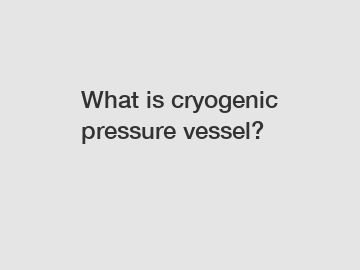Feb. 03, 2024
Machinery
What is a Cryogenic Pressure Vessel?
Cryogenic pressure vessels are containers specifically designed to store and transport substances at extremely low temperatures. These vessels have a crucial role in various industries, including aerospace, energy, healthcare, and research. But what exactly are cryogenic pressure vessels, and how do they work? Let's delve into the world of these specialized containers and explore their characteristics, applications, and safety considerations.
1. The Basics of Cryogenic Pressure Vessels.

Cryogenic pressure vessels are built to withstand the extreme temperatures and pressures associated with cryogenic fluids, which are substances cooled to below -150 degrees Celsius (-238 degrees Fahrenheit). The primary purpose of these vessels is to store and transport liquefied gases, such as liquid nitrogen, helium, argon, or oxygen. They are typically made from materials like stainless steel or aluminum alloy due to their excellent strength, high-temperature resistance, and low thermal conductivity.
2. Characteristics and Construction.
To ensure the safe handling of cryogenic materials, pressure vessels are designed with specific features. They possess a double-walled structure, with an inner vessel that directly holds the cryogenic fluid and an outer vessel that acts as a protective barrier. The space between the two walls is often evacuated or filled with insulation materials like perlite or vacuum insulation panels to minimize heat transfer.
Moreover, cryogenic pressure vessels are equipped with pressure relief devices, such as pressure relief valves, to prevent excessive pressure buildup. These safety mechanisms protect against potential ruptures or leaks that could lead to hazardous situations.
3. Applications of Cryogenic Pressure Vessels.
The versatility of cryogenic pressure vessels allows them to play a crucial role in various fields:
a. Research: Cryogenic pressure vessels are extensively utilized in laboratories and research facilities for experiments involving low-temperature processes, cryogenic cooling systems, or the storage of biological samples.
b. Healthcare: The medical industry relies on cryogenic pressure vessels for the storage and transportation of liquid oxygen, nitrogen, and other cryogenic gases used in hospitals, clinics, and research centers.
c. Aerospace: Cryogenic vessels are fundamental for space exploration as they are essential components of rocket propulsion systems. They store and supply supercooled propellants, such as liquid hydrogen or liquid oxygen, which are crucial for achieving high thrust efficiency.
d. Energy: Cryogenic pressure vessels are pivotal in liquefied natural gas (LNG) plants, where natural gas is cooled to a liquid state for easier storage and transportation. LNG helps optimize energy consumption and reduces greenhouse gas emissions during long-distance transport.
4. Safety Considerations.
Dealing with cryogenic materials and pressure vessels requires strict adherence to safety guidelines. Here are some crucial safety considerations for handling cryogenic pressure vessels:
a. Personal Protective Equipment (PPE): Individuals working with cryogenic materials must wear appropriate PPE, including insulated gloves, face shields, and goggles, to safeguard against potential frostbite or eye injuries caused by extreme cold.
b. Adequate Ventilation: Cryogenic gases can displace oxygen and cause asphyxiation. Therefore, it is essential to ensure proper ventilation in confined spaces or areas where cryogenic pressure vessels are stored or handled.
c. Proper Training: Anyone operating or handling cryogenic pressure vessels should receive comprehensive training on the properties of cryogenic fluids, correct handling procedures, and emergency response protocols.
d. Regular Maintenance and Inspection: Routine inspections and maintenance of cryogenic pressure vessels are vital to detect any defects, corrosion, or weak points that could compromise their integrity. This practice ensures the continual safe use of these vessels.
In conclusion, cryogenic pressure vessels are specially designed containers that facilitate the storage and transportation of liquefied gases at ultra-low temperatures. These vessels exhibit key characteristics such as double-walled construction, insulation, and pressure relief mechanisms to ensure their safety and reliability. From micro-scale research experiments to large-scale space missions, cryogenic pressure vessels find applications in diverse industries where temperature-sensitive materials are handled. Nonetheless, it is essential to prioritize safety through proper training, diligent maintenance, and adherence to safety protocols to ensure the optimal and secure utilization of these vessels.
Contact us to discuss your requirements of What Is a Dewar Tank?, bulk Cryogenic storage vessels, Horizontal Low Temperature Storage Tank. Our experienced sales team can help you identify the options that best suit your needs.
If you are interested in sending in a Guest Blogger Submission,welcome to write for us!
All Comments ( 0 )